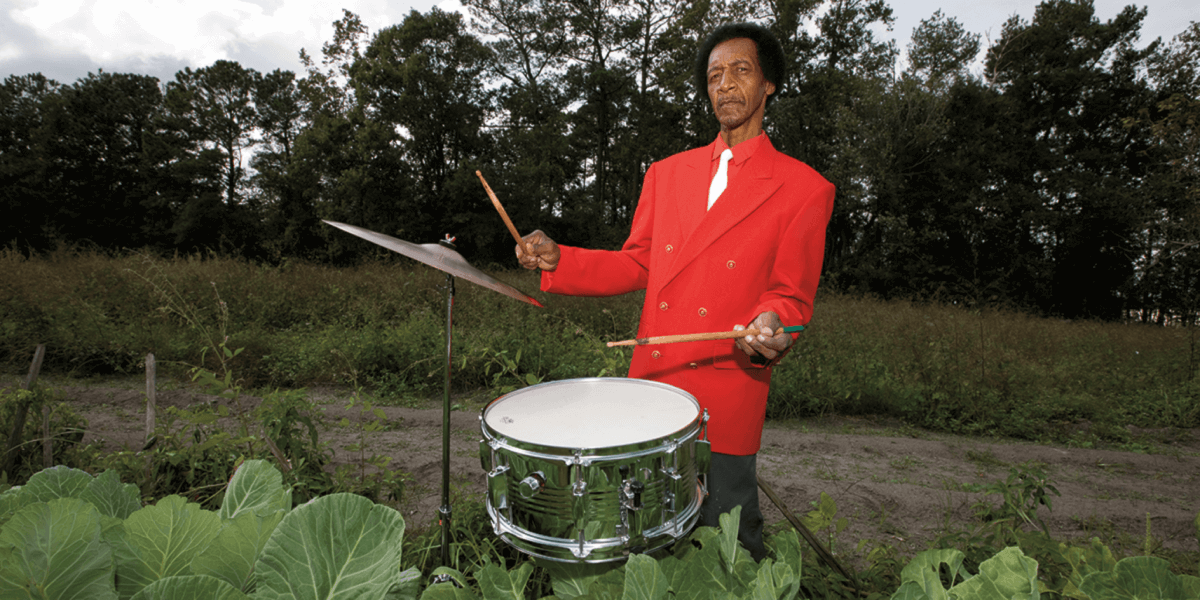
Clemmie Lee "Fig" Jones near his home in Pink Hill. An R&B and rock-and-roll drummer, Jones is holding the drumsticks that the early Kinston drummer Willie Moore gave him. (Photograph by Titus Brooks Heagins)
An eight-county trail in eastern North Carolina doesn’t just revisit our dark history of segregation. It lifts up Black joy by celebrating the North Carolina musicians who broke barriers and made remarkable music.
In segregation-era North Carolina, Bill Myers — of the historic, Wilson County R&B outfit The Monitors —remembers the rope down the middle of the room in white-owned venues.
In these venues, Black and white attendees weren’t supposed to mix. None of that mattered once the music started though.
“Music has that kind of magical power that brings people together and before we knew it, people were jumping over the rope to dance with each other,” Myers remembers. “Even though some people didn’t want to talk about it, the music had that effect.”
Music tears down walls. Myers, de facto father of NC’s African American Music Trail (AAMT), knows it for a fact.

Myers’ own group, The Monitors, was formed in Wilson in 1957, and plays a diverse range of music from jazz and blues to country. Named after the eclectic NBC radio program Monitor, the band has played with household names like James Brown, Otis Redding, and Millie Jackson. The band’s first vocalist was Roberta Flack, who went on to a chart-topping solo career.
Realizing that this rich heritage had been all but forgotten by the next generation of North Carolinians, Myers approached the NC Arts Council 20 years ago about creating a music trail in eastern NC.
“So much has happened here, stars like Louis Armstrong and Ella Fitzgerald coming to eastern NC and performing in the warehouses,” says Myers. “And we were all part of the Chitlin’ Circuit,” the Black-owned venues where Black musicians often went and played after the white clubs closed. In that era, Black performers were expected to leave immediately after they played the white clubs, so the Chitlin’ Circuit and its more accepting venues grew organically.
Still, Myers was surprised by how fast the AAMT got in motion, once he suggested it.
“Much to my surprise, the very next day [the executive director of the NC Arts Council] Wayne Martin sent a reporter to my house. She said, ‘I’ve been sent by Wayne Martin. We’ve been able to get $250,000 from the Department of Transportation and we’ve got to get this African American music trail started and you’ve got to direct us through this.’”

Celebrating Black Joy
Myers reconnected with area musicians to share and record their stories. These interviews became the basis of the AAMT guidebook, first published in 2013. The grant also helped jumpstart concert series and the construction of Kinston Music Park, a stunning outdoor performance venue with mosaics and murals honoring the region’s musical legacy.
The trail which spans eight counties, Edgecombe, Greene, Jones, Lenoir, Nash, Pitt, Wayne and Wilson, mainly attracted music lovers from the Triangle. Now, after two years in dormancy due to the pandemic, the trail is relaunching under new leadership for a global audience, to celebrate international African heritage.
Fortunately, Adrienne Nirde, the associate director of the NC African American Heritage Commission, and newly minted steward of the AAMT, saw the pandemic as an opportunity to examine how the trail worked in the past and what it might become.
Nirde hopes to expand concert offerings and programming at Kinston Music Park (the trail’s main infrastructure) and reach a wider audience in part with recent digital advances.
“In earlier iterations of the trail, we didn’t have the same kind of digital tools that exist now,” Nirde says. “So we are really looking at leaning into the digital space, creating itineraries, making sure that there’s an interactive map playing in the future.”
As music venues slowly reopened, the trail moved into a soft re-launch. But when the state declared 2023 NC’s Year of the Trail, Nirde and her team felt that June would be the perfect time for a hard re-launch.
The state seemed to be catching on to what Myers has known all along: that these celebrations of music, art and natural resources can bridge divides in situations otherwise unimaginable. And in the case of the AAMT, re-approach a difficult history of discrimination in the state.
“I think we’ve seen some cultural shifts in the past couple of years and we’ve seen an increase in folks wanting to educate themselves on this history. The AAMT music trail is an instance where we can focus on Black joy,” says Nirde.
To enjoy the AAMT during the soft re-launch, get a copy of the guidebook online and check out upcoming concerts. Don’t forget to sample some traditional local delicacies while you’re out.

3 things happening in NC: How to greet New Year’s in North Carolina
The Avett Brothers take their New Year's show to Asheville, Charlotte chefs collaborate for free soup tradition, Carolina Beach runners kickstart...

Check out the best New Year’s fireworks shows in NC, broken down by region
Check out these great fireworks shows, ranging from free to bougie, in each of North Carolina’s three geographical regions to end 2025 with a bang....

6 ‘good Samaritan’ acts in NC done by regular people
Read six heartwarming stories of "good Samaritans" doing kind deeds in NC. Now that the days are getting shorter, roughly 10 million Americans will...

6 ‘good Samaritan’ acts in NC done by regular people
Read six heartwarming stories of "good Samaritans" doing kind deeds in NC. Now that the days are getting shorter, roughly 10 million Americans will...

3 things happening in NC: Drive through High Point’s massive Christmas lights show
Cardinal & Pine's weekly roundup of NC happenings is a full-on holiday party this week. Drive through High Point's massive Christmas lights...




